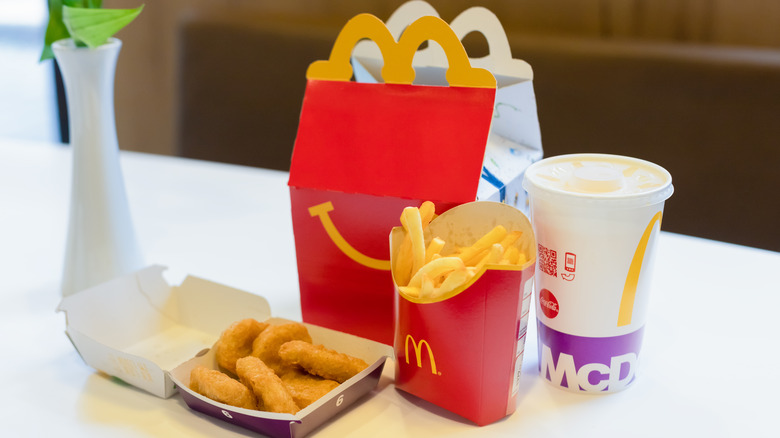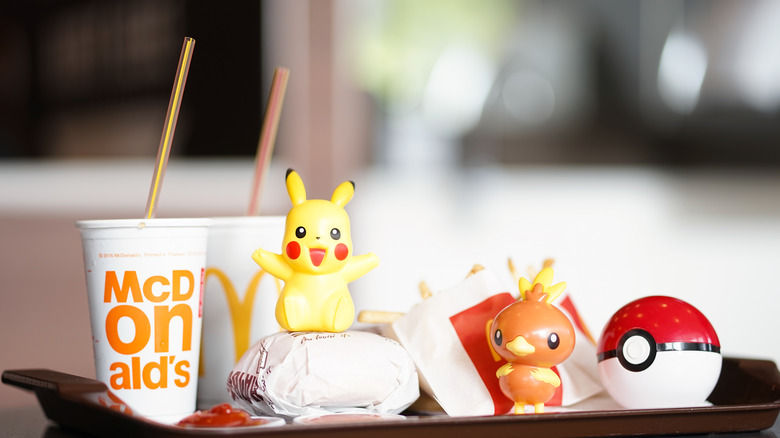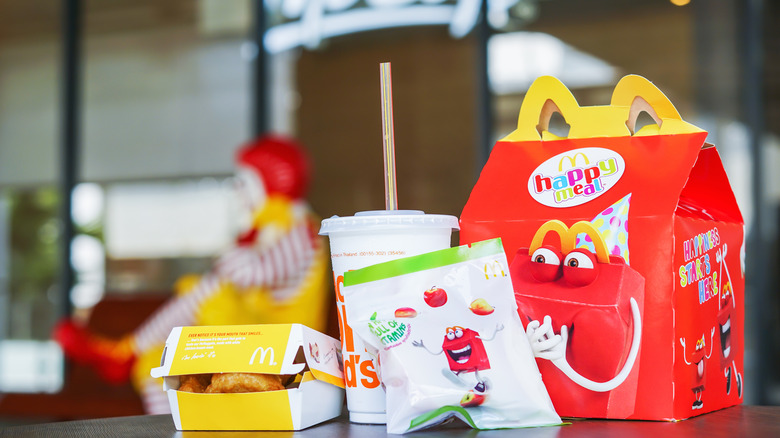Why San Francisco Placed Restrictions On McDonald's Happy Meals In 2010
Whether it was a favorite treat of yours when you were younger or you buy it for your own kids as a reward for getting good grades, McDonald's Happy Meal has been a popular meal with kids all over the world for many years. In fact, Nation's Restaurant News reported in 2018 that 30% of visits to McDonald's are "family visits," meaning that young children make up a noticeable part of the McDonald's customer base.
The origin story behind the kid-friendly combo meal can be traced back to one of two individuals in the 1970s. Some sources, such as CNN, tell us that the Happy Meal was invented by an advertising executive by the name of Bob Bernstein, while others like Newsweek point toward Guatemalan businesswoman Yolanda Fernández de Cofiño as the meal's inventor. Although two people are credited with the creation of the Happy Meal, the base concept has remained the same for many years: a colorful box with child-friendly foods like fries and apple slices, alongside a toy based on McDonald's itself or a popular franchise.
Although a Happy Meal may not sound like the sort of thing most folks get worked up about (unless it was over one of the "adult-friendly" Happy Meals that McDonald's released in 2022), you'd be surprised to learn that San Francisco actually had to put "restrictions" on the meal back in 2010. What was happening in San Francisco that such measures had to be taken?
It all has to do with the toys
If there's anything kids love more than McDonald's, it's toys. Combine the two into the beloved Happy Meal, and you'll have kids flocking to your door to get their hands on as many little plastic gadgets and toys as they can. But, for San Francisco, McDonald's wasn't able to give away toys in its Happy Meals unless they met strict criteria.
According to CNN Health, in 2010, the City of San Francisco adopted a law that prohibited McDonald's from placing free toys in its kids' meals since the meals didn't meet the city's nutritional guidelines. As originally conceived, the company would only be able to give out toys again when the Happy Meals were "redesigned" to contain fewer calories and more vegetables. The plan seemed to be that, by preventing McDonald's from using popular toys to promote its Happy Meals, children wouldn't be so enticed to go to the restaurant and order such an "unhealthy" meal.
The law, needless to say, did stir up some controversy, both in the minds of citizens and McDonald's itself. As the Los Angeles Times explains, a spokesperson for McDonald's claimed that the passing of the law was "extremely disappointing" and "not what our customers want." Others saw it as an example of the state muscling in on a private company — after all, McDonald's wasn't forcing kids to buy the Happy Meals, so why should the city of San Francisco tell the company what to do?
How did the ban affect McDonald's?
While there is no doubt that removing the free toy from the Happy Meal takes out a large part of what makes a Happy Meal so enticing, McDonald's, ever the shrewd hamburger company, found a loophole in San Francisco's law. NBC News tells us that, by 2011, McDonald's was still giving away toys with its Happy Meals — just not for free.
While a customer could still purchase a Happy Meal as they always have, they now had the option to buy the toy for 10 cents extra. This way, McDonald's could skirt around the newly imposed regulation. Since the company was now "selling" the toys rather than "gifting" them alongside the meal, it was entirely legal. While some, such as San Francisco Board of Supervisors member Eric Mar saw this as a "marketing ploy," it was announced no further action against the chain would be taken.
Of course, other restaurants quickly followed suit. In fact, Burger King, which was also targeted by the law, also began selling its toys on the side to go under the law. McDonald's, for its part, did do its part to make its Happy Meals healthier. This included reducing the number of fries served in a Happy Meal, adding more apple slices, and giving the option of nonfat chocolate milk (via Stanford Medicine). While it may not have been the sweeping changes San Francisco hoped for, it's at least a start toward a healthier kids' meal.


